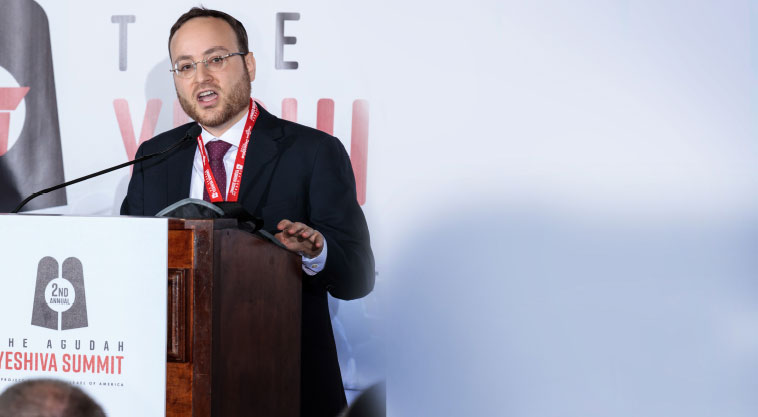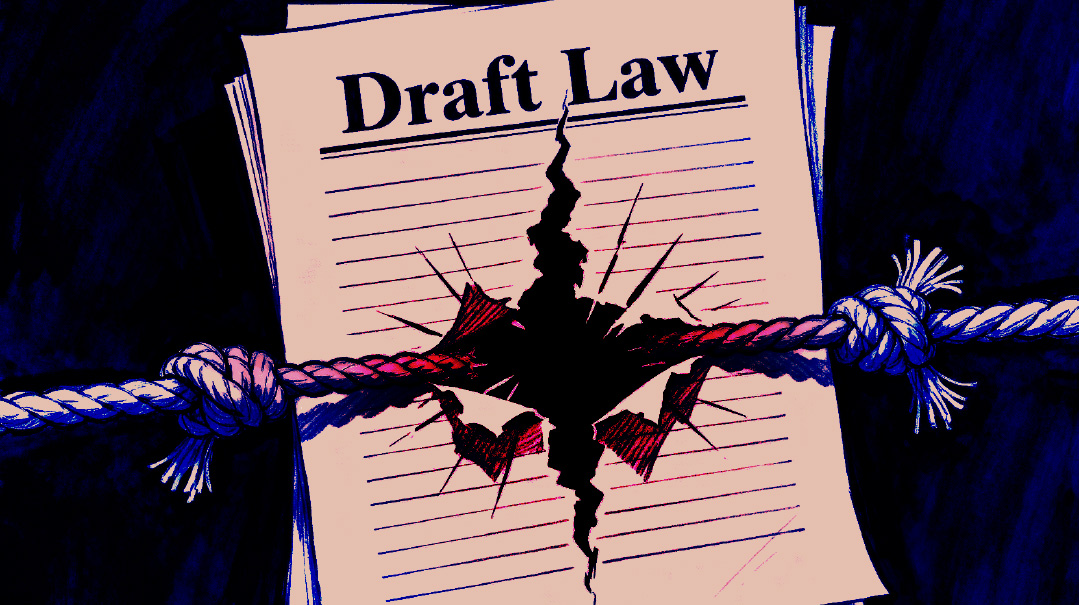No Sitting Out This Battle


Jewish private schools and yeshivos across the Empire State are justifiably worried about the New York State Education Department’s release of substantial equivalency guidelines that non-public schools are required to follow. These new instructions leave little flexibility for what yeshivos must teach, and the mandated number of secular studies hours is practically impossible to uphold. Are the headlines really true, or are there overzealous alarmists making people feel unnecessarily desperate?
To help make sense of all this, Mishpacha sat down with Avrohom Weinstock, Esq., chief of staff and associate director of Education Affairs at Agudath Israel of America, who says it’s time to wake up and gird up
Many leading rabbanim, most notably Rav Elya Brudny, have asked Mishpacha to raise awareness regarding this crisis. Why does it merit a greater response than so many other communal challenges we face?
A caveat: The guidance is something new, and at this point, there is uncertainty as to how it will be interpreted. Some have noted a line describing subjects taught for “180 minutes of instruction per week throughout the school year, or the equivalent.” Perhaps “or the equivalent” means the state will be satisfied with certain limudei kodesh studies. Perhaps integration of disciplines will be allowed, meaning an essay written on a historical topic can be used to satisfy requirements for both history and English.
This all might be true. And it might not. There is still lots of obscurity.
The bottom line is that the guidance requires over 35 hours per week of secular instruction for grades five through eight. That’s seven to nearly nine hours per school day, depending on how many days a week the yeshivah has secular studies. Presumably even more time would be required at the high school level. Moreover, the guidance prescribes subject time for English language, social studies, science, math, career training, physical education, health education, visual arts, music, library and information skills, and career development and occupational studies in a manner that could not possibly fit into the typical yeshivah day.
The state is planning to send the local public school district superintendent, or his designee, to begin substantial equivalence reviews beginning early 2019. The state intends to inspect every non-public school in New York state. Satisfying those kinds of draconian hour and course requirements with the above methods will not be simple, and cannot be left to the whim of a particular inspector’s interpretation of the guidance to determine whether a school can operate al pi Torah.
The United States has been a medinah shel chesed, allowing us to practice our religion, for many years. I would be thrilled if someone would come back to me in a year to tell me I was being an alarmist.
So, to answer your question: This move is unprecedented, and it’s a development we cannot afford to underplay. There are certainly many challenges we face as individuals and as a community. But the gedolim are alerting us that this is a threat at the existential level. As Rav Elya Brudny and Rav Yisroel Reisman have both told me, “We have to wake up the oilem!”
Was this unexpected? What was the reaction in Agudah?
Although the timing was no surprise, the content was more severe than expected. This guidance blows the doors wide open and puts every Jewish school in New York state — boys’ yeshivos, Bais Yaakovs, elementary schools, high schools, litvish, chassidish, Sephardi, and Modern Orthodox — in the bull’s-eye.
There is also evidence in the guidance of the work the Agudah invested, tirelessly shouldered by Rabbi Chaim Dovid Zwiebel in partnership with PEARLS (Parents for Education and Religious Liberty), over the past three years. It was necessary to explain our chinuch system to state education department officials who might otherwise be unfamiliar with what occurs in the religious portion of a yeshivah day. It was critical for them to understand that our children are not chanting religious hymns or playing video games during the substantial non-secular hours of the day.
Putting aside the indispensable kedushah and middos imbued, from a purely secular, educational perspective, there is tremendous value in learning a blatt Gemara. My sixth-grade son, for example, in addition to crunching through polynomial equations and reading and writing well above grade level, can engage in sophisticated logical reasoning while rattling off bletter Gemara in Eilu Metzios. The ra’ayos of Abaye and Rava involve deductive and inductive reasoning, proof by analogy, and articulating fine distinctions for rebuttal, all couched in a complex Aramaic linguistic overlay. My point is not that my son is bright (he probably takes after his mother), but that he is not an atypical product of our yeshivah system. We had a well-regarded professor from NYU demonstrate, point by point, how our curriculum more than satisfies the Common Core goals.
The guidance also includes several “core principles,” including mindfulness of parents’ right to choose the educational setting for their child, sensitivity that religious values may drive curriculum, and respect for another culture or values. It wasn’t necessary to include these details, by law, and their inclusion demonstrates that officials listened to our concerns.
However, on balance — and I won’t sugarcoat it — the guidance is worse than we were led to believe would emerge from this process.
“Core principles” are nice, but fluffy. There is little room for “mindfulness, sensitivity, and respect” when these selfsame guidelines also contain numerous detailed checkboxes to tick. Core principles require far more subtlety than a busy inspector, with hundreds of schools to visit, can realistically explore. These checkboxes seem to fly in the face of the values expressed.
What does “failure to comply” even mean? Does this just mean cutting funding? What does truancy mean on a practical level, and what are the ramifications?
These are important questions.
Yeshivos deemed “noncompliant” and that fail to become compliant after a short time will lose school lunch, bus service, Title services, textbooks funds — essentially all of the meager but much-needed services yeshivos rely upon from the state and federal government.
Moreover, students attending a “noncompliant” school must be transferred to a local public school or “compliant school” — or be deemed truant. Truancy is a violation of New York’s compulsory education law, which is a punishable offense to the parent. But that is a path I’d like to hope we never get to.
To be clear, this law fully applies even if a school agrees to forgo all governmental funds.
Do you feel this could create a new trend in other states?
Agudath Israel of America has worked with askanim worldwide regarding challenges to the chinuch system in the UK and Eretz Yisrael. Of course, the issues faced in other countries had different legal, social, and political nuances. But there is no question that a larger trend is occurring wherein an education with a healthy religious and moral component is less appreciated than it used to be.
And yes, this can certainly become a trend in other states.
In an August 30 Asbury Park Press interview, YAFFED founder Naftuli Moster, the prime mover behind the call for state intrusion into yeshivos, had a clear message about his organization’s ambitions for New Jersey, and Lakewood in particular: “You’re next.”
Time spent in secular studies should be spent wisely, and the New York state constitution requires that children emerge with a sound, basic education. I am not against that. I am against government overreach that prevents us from practicing our religion. It’s our job to make sure this ends here in New York.
I have heard some argue that the state provides “millions of dollars in funding to non-public schools.” Doesn’t that sort of give the state a right to regulate schools and dictate how non-public schools operate?
“Millions of dollars” sounds like a lot of money. But it doesn’t go very far when spread over 410,000 non-public school pupils in the state.
There is an interesting confluence of facts in New York state. According to the 2016 US Census data released last May, New York spent an average of $22,366 per public school pupil. That is the highest public school spend per pupil of any state in the country, and nearly double the national average of $11,392. Period. And unlike some 30 states (and growing), New York state offers no school vouchers, tax credits, tax deductions, or school choice program of any kind to those who pay taxes yet choose not to send their children to public school.
The minimal funds New York state does contribute are nearly all in the form of “mandated services reimbursement.” Mandated services reimbursement, an innovation of legendary Agudath Israel leader Rabbi Moshe Sherer a”h, simply reimburses non-public schools for the actual costs they incur to satisfy certain governmental requirements. Taking attendance and maintaining certain health records, for example, is a function our schools perform on behalf of the state, so the state provides limited reimbursement for that.
In the big picture, one wouldn’t expect that the state that spends the most per public school pupil and contributes one of the least per non-public school pupil, would also demand a level of oversight and control over the inner workings of non-public schools that is unprecedented in the United States.
Don’t get me wrong — one of the foremost missions of the Education Affairs division of Agudath Israel is to promote compliance and dina d’malchusa dina in yeshivos. We actually send an advisory memo to 1,400 school administrators every other school day, apprising, reminding, or clarifying a requirement relating to educational compliance, health, and safety. We provide live trainings, virtual trainings, and individual guidance. In our experience, schools are eager to comply, but they sometimes lack the resources or technical know-how to implement the myriad of city, state, and federal obligations imposed on them. That’s what we’re here for.
We believe this guidance, however, is a poor read of the current law, and one that imposes an unacceptable burden on the religious free exercise of nearly all Orthodox Jews.
Who decides our reaction?
The Agudah is guided by the einei ha’eidah, the gedolim in America, who work hand in hand with seasoned askanim. The Agudah, in a formal capacity, represents the interests of the yeshivah community before various governmental committees at the city and state levels.
The Agudah has also worked closely with PEARLS and Torah Umesorah. Avi Schick is an incredible, talented attorney who has been at the forefront of this issue, and his sister, Professor Adina Schick, has been a tremendous asset. There is room for others to join the fray. Our goal is the best possible outcome emerging for the tzibbur.
Were there mistakes made along the way?
As stated, I think we did a lot of things right. Agudah has been on this issue since day one. Their involvement, and the relationships developed, helped this become a more thoughtful exercise than it would have been had it been pushed through three years ago.
The formation of PEARLS, wherein diverse chassidic groups are working together, b’achdus, to pool resources and improve education, was also an impressive accomplishment.
But the bottom line is that the guidance is not favorable, and I am not ashamed to say that there are areas we need to improve. Before I joined Agudah, I was a TAG volunteer, to help families engage technology responsibly, and am proud to have been part of the team that launched TAG in my community.
No, I’m not endorsing that we all engage in social media, or bring the Daily News, New York Post, and New York Times into our homes — but Mishpacha readers should be aware that these outlets have, for the past three years, been blasting one message in unison on this topic: that ultra-Orthodox religious zealots are intent on releasing their throngs of parasitic, uneducated hordes onto New York state; that their rabbis are trying to keep their children ignorant either as a means of control, or because those rabbis don’t realize these children may someday need to earn a living; that the powerful religious leaders, by running these anachronistic religious schools, have used their untold wealth and Elders of Zion-esque political influence, to evade the law; that YAFFED, and its courageous band of counterculture, educational warriors, are the Davids fighting the rabbinic Goliaths, trying to save the Ultras from themselves and the powerful, religious, political machine.
I don’t know what the answer is as far as pushing back is concerned, but that is not a narrative many of us should feel comfortable with. We can’t let a small group of activists, who may have had an unfavorable yeshivah experience or attended a yeshivah not suited for them, be the only voice on the subject, rocket-fueled by a particular media perspective.
At the same time, it would be a mistake to think the current challenge is all YAFFED’s work.
There are several forces at work that created the fertile ground for this to occur. The ACLU and liberal-leaning law firms are providing extensive pro bono legal support for the cause. Footsteps, an organization that “supports individuals and families who have left, or are contemplating leaving, insular ultra-Orthodox Jewish communities in their quest to lead self-determined lives,” has been an active supporter. Indeed, Footsteps just filed an amicus court brief encouraging the court to subject yeshivos to even greater scrutiny. And of course, there is the media, which will not even publish alternative perspectives proffered by Agudah on this issue.
We Orthodox Jews often have families, pay tuition, and live in high-cost areas. Sometimes it seems like our lives run from one thing to the next — trying to make a parnassah, learn seriously, do homework with (for?) our kids, and simply get though life. But we cannot afford to be complacent. Galus America is also galus. Nothing is guaranteed.
(Originally featured in Mishpacha, Issue 739)
Oops! We could not locate your form.













